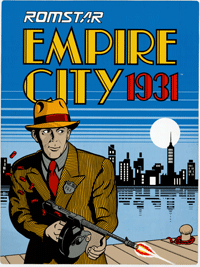| Empire City: 1931 | |
|---|---|
 Arcade cabinet side art | |
| Developer(s) | Seibu Kaihatsu [1] |
| Publisher(s) | ArcadeFamily Computer/MSX Toshiba EMI [1] |
| Producer(s) | Hitoshi Hamada |
| Platform(s) | Arcade Family Computer MSX |
| Release | ArcadeFamily ComputerMSX
|
| Genre(s) | Shooter |
| Mode(s) | Single-player, multiplayer [6] |
Empire City: 1931 [a] (known as Street Fight in Germany and the Benelux Union) is a shooter game developed by Seibu Kaihatsu that was originally released into arcades in 1986, by Taito in Japan and Europe and by Romstar in North America. The game has players taking on the mafia in 1931 New York City by gunning down mobsters one by one.
Contents
Versions of the game were released for the Family Computer (1987) and MSX (1988) as Magnum Kiki Ippatsu: Empire City 1931. [b] [7] Acclaim advertised a release for the Nintendo Entertainment System in Western regions, but the console version remained exclusive to Japan. [8]
Seibu Kaihatsu eventually released a follow-up game, Dead Angle .
